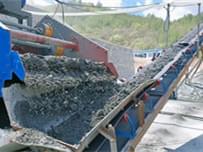9 differences between linear and circular vibrating screen
Vibrating screens have a wide variety of types according to the movement track of materials, such as, circular vibrating screens, linear vibrating screens and fine screening machine, and these three are the most commonly used types in daily production.
Classification of vibrating screen
According to the material trajectory of vibrating screen can be divided into:
Fine screening machines are used less in the production of broken grinding, so the comparisons here are mainly for linear screens and circular screens. Actually, there is no essential difference between circular vibrating screen and linear vibrating screen on the pattern and structural composition. The materials are sieved by the vibration of sieve surface to achieve the purpose of screening, but the difference in vibration trajectory will directly affect the purpose of screening.
Working principle
Circular vibrating screen
The motor is driven by a V-belt to produce a high-speed rotation of the exciter eccentric and generates a large centrifugal inertial force, which excites the circular vibrating screen to generate a circular motion of a certain amplitude. Material on the screen is subjected to a continuous throwing motion by the impulse transmitted from the screen box on the inclined screen surface, and the particles smaller than the sieve hole are sieved in the process of meeting the screen surface to realize the classification.
Linear vibrating screen
Vibration motor is adopted as the vibration source to cause the material to be thrown up on the screen while moving forward in a straight line. Material enters linear vibration screen from the feeding port uniformly, and several different kinds of oversize and undersize products are produced through the multi-layer screen, and are respectively discharged from the respective outlets.
Differences contrast
1. Motion track
The material on circular vibrating screen is circularly moved, and the material on linear sieve moves forward in a straight line.
2. Exciter
Circular vibrating screen is also named single-axis vibrating screen because the exciter is a shaft and operates with an inertia motor. Linear vibrating screen exciter consists of two shafts and works on the principle of vibration motor excitation, so it is also called biaxial vibrating screen.
3. Plugging phenomenon
The material of circular vibrating screen moves in a parabolic circular path on the screen surface, so that the material is dispersed as much as possible to improve the material jumping force, and the material stuck in the sieve hole can also jump out, thereby reducing the phenomenon of plugging holes.
4. Installation layout
Due to the small inclination of linear screen surface, the height of sieve is reduced, which facilitates the process layout.
5. Screen inclination
According to the particle size of material, the inclination angle of screen surface of circular vibrating screen can be changed, thereby changing the moving speed of material along the screen surface and increasing the processing capacity of screen machine.
6. Materials
Generally, the plate used in the production of circular vibrating screen is thicker, and the box is made of manganese steel to resist the impact of material during the screening process.
The materials for the production of linear vibrating screens are mainly light-weight plates or stainless steel plates.
7. Applicable fields
Circular vibrating screen mainly used to classify materials with large specific gravity, large particles and high hardness. It is widely used in mining industries such as mines, coal and quarrying plants.
Linear screens are mainly for fine particles, light weight and low hardness materials, and is mainly composed of dry powder, fine granules or fine powder materials. They are widely used in food, chemical, building materials and pharmaceutical industries.
8. Processing capacity
For the circular vibrating screen, since the exciter is arranged above the center of gravity of screen box, and the upper end of elliptical long axis of the feeding end faces the discharge direction, the material is quickly dispersed. The upper end of elliptical long axis of the discharge end is opposite to the discharge direction, which reduces the movement speed of the material, and is beneficial to the screening of difficult-to-screen materials. And the arc-shaped screen surface increases the effective area of the screen machine, thereby improving its processing capacity.
In addition, for the difficult-to-screen materials, circular vibrating screen can make the main shaft reverse, so that the vibration direction is opposite to the moving direction of the material, and the moving speed of the material along the screen surface is lowered to improve the screening efficiency.
9. Environmental protection
Linear vibrating screen can adopt a fully enclosed structure without dust, which is more conducive to environmental protection.
In the fields of sand crushing or sand washing, circular vibrating screens has a large number of applications. In actual production, adopting circular vibrating screen or linear vibrating screen is mainly depends on the type of material and the application field handled by users. The purpose of screening is different, and the selected equipment is also different.



















Send Message
Please write down your requirement and contact details in the following form. You can also send a message to us by this email export@lylzzg.com, we will reply to you within 24 hours.